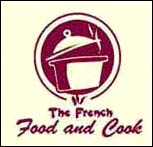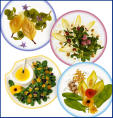|
Lesson #2 Exploring the World of French Cuisine
 About
4 classes About
4 classes
Aim: Exploring the
World of French Cuisine
Materials: computer,
Internet access, Venn Diagram, French Dialogue, French Vocabulary
Do Now: Answer the following questions in English
- What does the word cuisine mean?
- What is the difference between a fast food restaurant and a regular restaurant?
- List 5 fast food restaurants and 5 regular restaurants in your area
 STEP 1 STEP 1
Website: After reviewing do now go to the website http://atkielski.com/inlink.html?/main/ParisFastFood.html
This website will allow the students to explore the differences and similarities between Paris and NY (Brooklyn) in the areas that they live in.
Allow the students to search each link to the fast food restaurants. Let them navigate and read through the information on the site. You can either do it together as a class and do a round robin reading session or let the kids do it as independent reading.
Cooperative Learning groups: Give each group a Venn- Diagram.
It
should reflect ideas about eating in France, B should reflect ideas about eating in the U.S. and C should reflect what the students have found to be the same in both countries. Here is the link to the Venn Diagram one of my classes used
(right click and download, MS Word document): COMPARE AND CONTRAST EATING
Print out a copy of the Venn Diagram and give each group
ample time to fill it in. Allow for discussion and each group should present their ideas to the class.
STEP 2
(Students should have prior knowledge of French numbers to 60)
Present a simple dialogue to students conveying the importance for politeness and formality.
Please, Thank you, you're welcome, It was nothing, There is no problem.
S'il vous plait, merci, Je vous en prie, ce n'est rien, Il n'y a pas de quoi.
(Marie and Pierre go to a café to get a drink)
Marie et Pierre: Bonjour monsieur
Le garcon: Bonjour Madame et Monsieur
Marie: un café, s'il vous plait.
Pierre: une limonade, s'il vous plait.
(The waiter brings the coffee and lemonade)
Pierre at Marie: Merci
Le garcon: Je vous en prie
(They are finished with their beverages and are ready to leave. Pierre signals for the waiter)
Pierre: C'est combien le café et limonade, s'il vous plait?
Le garcon: Douze francs s'il vous plait.
Marie : Voila douze francs.
Marie et Pierre: Au Revoir.
Le garcon: Au Revoir, je vous en prie.
Group Activity: Have students work in groups of three and make up their own conversations. Each student will play a role and have a speaking part. The group will present their dialogue to the class. Allow students one class to prepare and practice dialogue. Students may bring in props and food as visual aids for the performance. Use a rubric to grade the presentation, here is my rubric: ORAL PRESENTATION RUBRIC.
But, if you would like to create your own use the following link:
http://teachers.teach-nology.com/web_tools/rubrics/oralex/ |